Keeping live plants with Koi and Goldfish has gained a lot of popularity in the pond and aquarium hobby. There are many plants you can keep with koi and goldfish carp but some plants will do much better than others.
The ideal plants for koi and goldfish are plants that can live in the same environment as carp can. The main water parameters you will need to check to make sure plants can live with these fish are the water pH and temperature. The depth that the light can reach is also another important factor to keep in mind.
Fortunately, most plants can tolerate koi and goldfish water conditions. Though the extreme conditions that carp can tolerate might be lethal for some plants. This is why we categorized these plants into indoor and outdoor plants so you accidentally do not add sensitive plants to your outdoor pond.
In this article, we’ll go through the benefits of having live plants in your outdoor or indoor pond or aquarium and recommend the best plants to keep with them. We divided plants into indoor and outdoor plants to make choosing easier for you.
Why Keep Plants With Koi & Goldfish?
The pond or the aquarium where you are keeping your koi and goldfish is a tiny ecosystem that needs to stay stable. Plants will not only make your tank beautiful but will also remove toxins and fish waste from the water. This will provide a cleaner environment for your fish to live in.
The good news is that many plants do best with carp and will keep the water clean and healthy for the fish. These plants can be great for oxygenating the water as well. They can also provide shelter for fish or other inhabitants that are under stress.
In an outdoor pond, live plants will attract many different small species that can become a free source of food for koi. They will also help the pond to stay more stable and act like a tiny ecosystem. At the same time, live plants will provide shade on sunny days keeping the water cooler for the fish.
Indoor ponds and aquariums will also need live plants to function naturally. Because the heat in the house is usually more stable than in outdoor conditions, it is much easier to keep different types of live plants with these fish. The good news is that many aquarium plants can live in harmony with koi and goldfish.
The Best Indoor Plants for Koi & Goldfish
Buying live plants for a koi and goldfish can be tricky as these fish will eat many types of plants. However, many plants are hardy enough to withstand a carp’s nibble. These plants are also easy to grow and are fairly cheap to source. This makes it easy to figure out which ones work best for your fish.
Here are our top choices of plants to add to your koi or goldfish tank.
1. Anubias
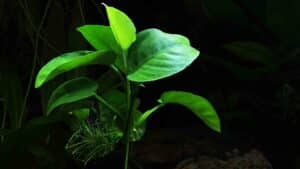
The Anubias genus is one of the hardiest aquarium plants you can get. These aquatic plants are extremely low-maintenance and come in a variety of shapes and sizes. These plants have large and thick leaves that are hard for koi or goldfish to bite and destroy.
At the same time, Anubias are water column feeders, which means they don’t require substrate. You can simply attach them strongly to decorations and leave them in the tank.
The Anubias genus has several variations, a large number of them have large leaves and grow very big which are ideal to keep with these fish. The larger the plant the better chance it has to grow.
These plants are native to western Africa but they are now available in most regions of the world. This makes them a widely available plant that is also very affordable. To learn more about Anubias you can read our detailed care guide here: Anubias Care Guide
2. Buce Plants (bucephalandra)
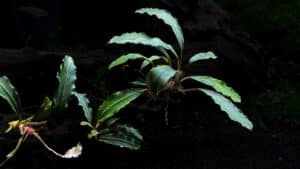
Bucephalandra species, sometimes known as “Buce Plants,” are well-known for their easy maintenance and hardiness. When it comes to their care and nature, they share a lot of similarities with anubias.
These plants can survive in severe environments and have hard leaves that your koi will not try to bite. These plants can also thrive in low-light conditions which makes them great plants for indoor ponds.
There are several bucephalandra species that you can choose from. However, we recommend going after larger and harder types to ensure they have the best chance to survive.
They are also slow-growing plants, so you won’t have to trim them as frequently. Same as anubias, they feed from the water column and do not require substrate. To learn more about Bucephalandra you can read our detailed care guide here: Buce Plants Care Guide
3. Marimo Moss Ball
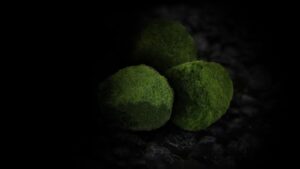
Marimo Moss Balls are among the greatest algae to have in a tank or pond. Despite its name, Moss Ball is a species of algae that naturally grows into a ball shape. Because it can thrive in any environment, it can be a great plant to add to your pond.
Your fish will constantly play and move around. This gives your fish some fun activities to play and will make your moss ball hold its shape over time. While most fish will not bother these algae, some koi or goldfish might try to eat it. So if you see your fish are not happy with adding moss balls to your tank you will need to remove them as soon as possible.
These algae will not spread and will maintain their spherical form at all times. This makes them the only algae we intentionally want to add to our tank.
Marimo means “seaweed ball” in Japanese, but Moss Ball is more frequent because it has become famous for it. To learn more about Marimos you can read our detailed care guide here: Marimo Moss Ball Care Guide
4. Java Fern
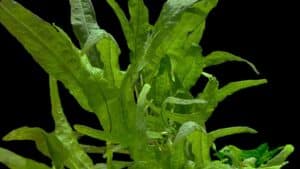
The Java Fern is another excellent choice for a betta vase or koi and goldfish indoor ponds or aquariums. This plant is hardy and can tolerate a wide range of water parameters. Most koi and goldfish do not show any interest in eating this plant which makes them a great plant to try.
This plant is also a beginner-friendly species since it can thrive without a substrate. With their slow growth rate, they require little maintenance and trimming. They have large and hardy leaves that your fish will not find edible.
Because this is a rhizome plant, you will need to make sure the rhizome does not get covered with the substrate. This is critical to remember since your plant can die if the light can not reach the rhizome. To learn more about Java Fern you can read our detailed care guide here: Java Fern Care Guide
5. Vallisneria (Jungle Val)
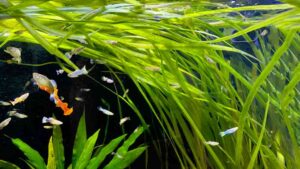
If you want to create a lush jungle in your pond, Jungle Val or Vallisneria is the plant to go with. This plant is low-maintenance and will grow huge and tall. This makes them a great choice for koi and goldfish tanks.
They will also regularly shoot new runners and proliferate, giving your tank the appearance of a thick jungle. The koi and goldfish also seem to not like to eat them. But they might uproot them so you will need to plant them securely.
Vallisneria plants are found only in North and South America and need a similar environment to thrive. They also require intense lighting, so make sure to use a full spectrum of light if you want to keep these plants.
When you initially purchase this plant, your fish might go after its dead leaves, which is normal. But after a while, you will see your plants begin to come back to life and grow strongly.
They are a fast-growing species that requires a well-planted substrate to thrive. This means you will have to invest in a good substrate or root tabs to have this plant grow naturally. To learn more about Jungle Val you can read our detailed care guide here: Jungle Vallisneria Care Guide
The Best Outdoor Plants for Koi & Goldfish
Keeping plants in an outdoor pond can be rewarding. Your fish will also appreciate these plants as plants can give them a better living space. Fortunately, there are many plants available to plant in a pond. They can be fully submerged types of plant or semi-aquatic plants.
All the plants we mentioned above can also grow outdoors if you are living in a tropical area. But they are fully submerged plants and you might not be able to enjoy them looking from above. Those plants also can not survive cold winters so it’s best to pick one of the following plants for your outdoor ponds.
6. Water Lotus (Nelumbo lutea)
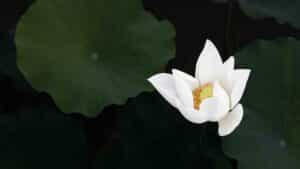
Lotus plants grown in warm water require almost minimal maintenance. Lotuses aren’t very appetizing to koi or goldfish, and they’re great plants since they can create shade for your fish throughout the summer.
Lotuses, although popular and visually appealing floating aquatic plants, are fussy and require a lot of care. They flourish in water that is 75–87 degrees Fahrenheit. The water needs to be at least 18 inches deep so they can grow their roots and stems naturally. They also prefer low humidity, and at least 5 hours of sunlight daily.
These exotic-looking plants can grow large so they need a lot of surface space. This makes them great plants for larger ponds. The dwarf varieties of these plants are also available if you want to add them to your small ponds.
7. Water Lily (Nymphaea)
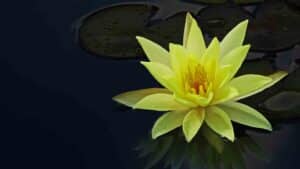
Water Lily is a great surface floating plant that can come in different shapes and colors. With their wide range of shapes, sizes, and colors, water lilies are a wonderful complement to any water feature.
The lily is a popular plant for ponds because it resembles the lotus plants without growing hugely. They can also thrive in colder waters and require less direct sunlight which makes them a better choice of plants.
Water Lily is a great surface floating plant that produces amazing-looking flowers. They need less care and maintenance which makes it easy for you to keep them. Koi and goldfish seem to enjoy the company of this plant as they are often seen swimming around water lilies.
8. Water Lettuce (Pistia stratiotes)
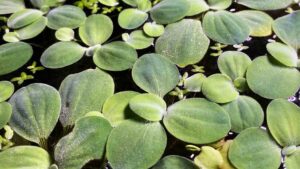
Water lettuce is a great greenery you can add to your pond. By adding Water Lettuce to your pond, you can easily enhance the water conditions your fish live in. This hardy variety of surface-floating plants will grow rapidly and thus will remove toxins quickly.
If given the chance, this plant will spread quickly and will develop a green carpet throughout your whole pond. This rapid reproduction means they will quickly consume the toxic fish waste produced in the pond. They will also give your fish more shade to feel safe and sound.
Water lettuce thrives in the calm, slowly flowing waters of ponds. Their large yet fragile roots can provide your fish with some free food as well. But because of their fast reproduction mechanism, even if your fish consume some of the roots these plants will still grow without any problems.
For more information about his plant please follow this link: Water Lettuce Care Guide
9. Water Hyacinth (Eichhornia crassipes)
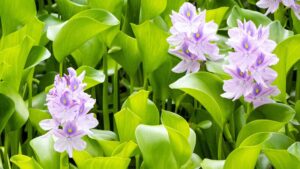
You can’t have a pond without a water hyacinth! This plant is one of the most famous pond plants used by almost any pond keeper at some point. These lush green plants are extremely beautiful and unique looking and can produce beautiful flowers.
The water hyacinth is an aquatic plant that floats on the surface of the water and shoots its beautiful purple flower out in the air. The flower will attract all kinds of insects, butterflies, and even hummingbirds. Which will make your pond look very natural and beautiful.
They thrive in a wide range of weather conditions which makes them great plants for most parts of the United States. They are super hardy species and can grow in places where most other plants can’t grow.
10. Scouring Rush (Equisetum)
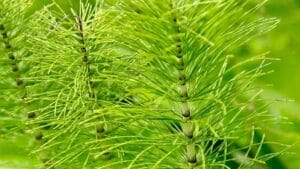
Scouring rush and other Equisetum species are super hardy plants that can be a great addition to your outdoor pond. These plants are known as “living fossils” for their hardy nature and survivability.
These plants are great at stabilizing the substrate and preventing erosions. They are also excellent plants to filter the water. This makes them a great choice for most outdoor ponds.
This prehistoric plant has been around for millions of years and survived a few ice ages. These are ideal plants to keep with your koi and goldfish to make them feel safe. These fish also lay their eggs among the densely grown Scouring Rush on the banks of your pond.
These plants are easy to grow and also easy to remove. They will stay in the area you plant them and will not spread like other plants. They develop deep root structures which will help the substrate to stay in place.
Will Goldfish Or Koi Carps Eat My Plants? (How To Stop them)
Koi and Goldfish are types of carp and they will eat most of the plants. However, some plants look less appealing to these fish. The plants we mentioned here are some of the least desired plants for these fish to eat.
Your fish likely go after these plants as well but if you feed them properly and on time you are giving your plants a better chance of survival. When your fish are well-fed, they will not go after these plants as they don’t find these plants very appetizing.
Some of the plants we mentioned will also grow rapidly, so even if your fish try to eat them they will reproduce quickly to recover from the loss. This also means you will not need to feed your fish as often.
To fully stop your fish from eating plants you can also protect the plants with wire mesh. This is a great idea if you have large fish and not enough plants in the pond. You might need to protect the plant for some time until it can establish itself and start reproducing.
You can also plant the root-feeding types of plants in pots to make sure the fish do not uproot the plant. Pots will also prevent the fast-growing plants to stay contained and prevent plant overpopulation.
Your fish will only go after plants if they are hungry, so by feeding them more often you can protect your plants. Having a few types of foods that have higher plant contents also seem to help with the plant grazing of these fish.
Conclusion
Though we divide the plants into indoor and outdoor types, under the right conditions, all these plants can live indoors and outdoors. Each fish also has a different personality and some might not show any interest in plants while others eat any plant you add. So it’s best to check each type of plant and see which ones are best for the area you live in and if your fish can live in harmony with them.